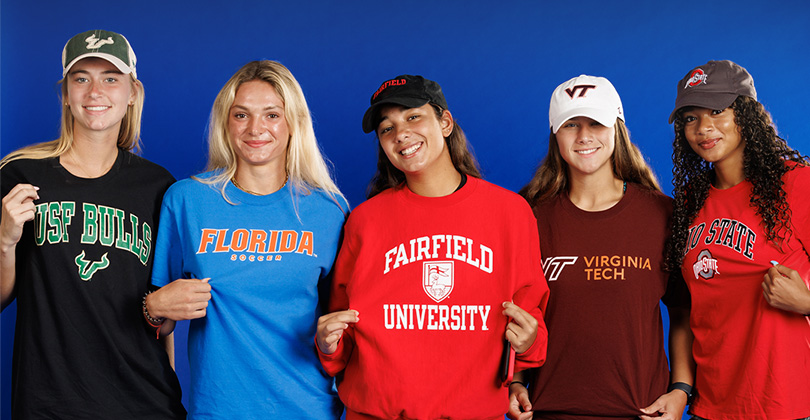Updated June 2025
Big changes are coming to D1 sports with new NCAA scholarship rules, athlete payments and roster limits and more set to roll out in the 2025-26 school year with the recent settlement in the House v NCAA lawsuit, which marks a transformative shift in college athletics.
Below we go over the scholarship settlement offer in detail, discuss how they could affect recruiting for student-athletes, what other changes are coming to college sports and offer practical tips for navigating these changes to stay ahead in your sports journey.
Want to speak with an NCSA expert? Click here to learn more about our premium memberships.
It is clear that the value of a roster spot for college athletes is changing. You can read more on that from IMG Academy here.
NCAA Scholarship Rules: What WOULD ChangE?
Let’s explore the changes coming to NCAA D1 sports for the 2025-2026 academic year for schools that opt in to the settlement.
- No Scholarship Cap: NCAA D1 schools will be able to offer scholarships to every athlete on their roster, eliminating previous sport-specific limits. This means schools will have more flexibility financially supporting their athletes, increasing the number of potential college sports scholarships.
- New Roster Limits: NCAA is introducing new roster limits that match or exceed current scholarship restrictions for each sport. With scholarship caps gone, most programs will be able to offer more scholarships. However, they must follow the new NCAA roster limits for each sport. For example, NCAA football scholarship limits will have a roster cap of 105 players, up from 85. Keep reading to see the full list of new roster limits for all NCAA D1 sports, including the current and new numbers
- Scholarship Type: All sports will now be classified as equivalency sports, allowing schools to offer partial scholarships. This is a huge change from the current system where some sports, like football, basketball and volleyball, are headcount sports and only offer full scholarships.
- Direct payment: Starting in 2025, schools can opt to share a “cap” of up to $20.5 million with their student-athletes, beginning July 1, 2025. It is up to schools to decide how that money is shared and not all will have the funding to do so (more on that below).
- NIL: Student-athletes will still be able to profit off of their Name Image Likeness but there will be changes to regulation of the deals and enforcement.
What Are the New PROPOSED NCAA Roster Limits?
New roster limits will be introduced for NCAA D1 sports for the 2025-2026 academic year. These changes will allow more players to receive college athletic scholarships, but teams will also have to follow new maximum roster size limits.
Note, only the power five conferences and Notre Dame are required to opt in to these changes, though a number of other schools have already said they will as well across every level of D1 play (more on that below).
NCAA Scholarship Limits for D1 College Sports Programs
In the table below, we break down the roster changes that will be made to every D1 sport for schools that do opt in.
| Sport* | Current | New | Increase |
|---|---|---|---|
| Tumbling (W) | 14 | 55 | 41 |
| Baseball (M) | 11.7 | 34 | 22.3 |
| Basketball (M) | 13 | 15 | 2 |
| Basketball (W) | 15 | 15 | 0 |
| Beach volleyball (W) | 6 | 19 | 13 |
| Cross country (M) | 5 | 17 | 12 |
| Cross country (W) | 6 | 17 | 11 |
| Field hockey (W) | 12 | 27 | 15 |
| Football (M) | 85 | 105 | 20 |
| Golf (M) | 4.5 | 9 | 4.5 |
| Golf (W) | 6 | 9 | 3 |
| Gymnastics (M) | 6.3 | 20 | 13.7 |
| Gymnastics (W) | 12 | 20 | 8 |
| Ice hockey (M) | 18 | 26 | 8 |
| Ice hockey (W) | 18 | 26 | 8 |
| Track (M) | 12.6 | 45 | 35.4 |
| Track (W) | 18 | 45 | 27 |
| Lacrosse (M) | 12.6 | 48 | 35.4 |
| Lacrosse (W) | 12 | 38 | 26 |
| Rowing (W) | 20 | 68 | 48 |
| Soccer (M) | 9.9 | 28 | 18.1 |
| Soccer (W) | 14 | 28 | 14 |
| Softball (W) | 12 | 25 | 13 |
| Stunt (M/W) | 14 | 65 | 51 |
| Swim (M) | 9.9 | 30 | 20.1 |
| Swim (W) | 14 | 30 | 16 |
| Tennis (M) | 4.5 | 10 | 5.5 |
| Tennis (W) | 8 | 10 | 2 |
| Triathlon (W) | 6.5 | 14 | 7.5 |
| Volleyball (M) | 4.5 | 18 | 13.5 |
| Volleyball (W) | 12 | 18 | 6 |
| Water polo (M) | 4.5 | 24 | 19.5 |
| Water polo (W) | 8 | 24 | 16 |
| Wrestling (M) | 9.9 | 30 | 20.1 |
| Wrestling (W) | 10 | 30 | 20 |
*D1 sports not shown in the table, including Bowling, Fencing, Equestrian, Rifle and Skiing, will also have scholarship and roster implications.
When WOULD the New NCAA Scholarship Rules Start?
The new scholarship rules and roster limits for NCAA D1 sports will start in the 2025-26 academic year.
How WOULD NCAA Roster Limits Impact Walk-ons?
Walk-ons have historically been a big part of D1 programs because of current NCAA scholarship limitations. But with the new NCAA scholarship rules and roster limits starting in the 2025-26 school year, coaches will need to rethink how they manage scholarships and roster spots. The exact impact on walk-ons is unknown at this time and will vary across different sports and schools, depending on their size and budget.
To understand how roster limits might affect you, we recommend staying in touch with coaches. Ask them about their plans for walk-ons, as this can vary widely between programs.
How Will Schools Adjust to the New NCAA Scholarship and Roster Limits?
Adding more scholarships across all sports could mean big financial changes for D1 schools. It isn’t clear exactly how college programs will adjust to the new rules, since it will vary by sport and program.
As more details come out, we’ll share how schools are managing these updates. In the meantime, stay in touch with the schools you’re interested in and ask how these updates might impact your recruitment and athletic scholarship opportunities.
Will Student-Athletes Get Paid To Play College Sports Now?
Maybe, but it depends.
- Starting in 2025, schools can opt to share a “cap” of up to $20.5 million with their student-athletes, beginning July 1, 2025. That cap may grow by ~4% annually.
- Each school decides how to allocate that money
- Football and men’s basketball will likely receive the largest shares
- Other sports — like softball, track, or swimming — may receive much less. In some cases, teams may only receive a few hundred thousand dollars to divide across the entire roster
are more changes coming?
Yes, this is just the beginning. Many details still need to be finalized, and additional legal challenges are expected:
- A “cap” limits how much schools can pay. If that cap is seen as unfair, it may be challenged in future lawsuits
- Families should expect recruiting, roster management, and scholarship models to evolve in the coming years
Which student-athletes are covered by the settlement?
This applies to all Division I student-athletes who:
- Competed on or after June 15, 2020
- Or will compete anytime through June 5, 2035
That includes today’s middle schoolers, high schoolers, and postgrads aiming to play Division I sports.
Do all schools have to follow the new model?
- All Power 5 schools (plus Notre Dame) must follow the new rules
- Other Division I schools can choose to opt in
- Division II and III schools are not yet affected — though future adjustments may eventually ripple into those divisions
what if i lost a roster spot because of this?
If a school cut a student-athlete in preparation for this settlement:
- They’re required to offer that roster spot back
- The student-athlete won’t count against team roster limits
- However, coaches still retain the discretion to determine whether a student-athlete is a fit for their program
What else is changing?
- The NCAA is eliminating 150 outdated rules to modernize student-athlete benefits
- A new governing body, the College Sports Commission, will oversee enforcement
- A tech platform, NILgo, will help schools track athlete compensation and ensure compliance. Any third-party NIL agreement over $600 will be reviewed, with external arbitration if disputes arise.
Preparing for the change
The upcoming changes to NCAA scholarship rules and roster limits are set to take effect in the 2025-26 school year. While the full impact on student-athletes and potential recruits is still unfolding, it’s crucial to stay informed and proactive.
Here’s what you can do right now to prepare:
- Stay Informed and Ask Questions: Keep an eye on updates from schools and the NCAA regarding the new rules. Engage with college coaches to understand how their programs plan to implement the changes.
- Educate Yourself and Follow NCSA: Learn about the new rules and their implications. Stay connected with NCSA for the latest information and guidance on navigating these changes through our blog, website and social media! Click here to see our live workshops.
- Show Your Value and Focus on Performance: Highlight your skills to coaches, demonstrating your versatility and value. Maintain strong academics and athletics, as both are critical in scholarship decisions. Click here to learn more about how to get recruited.
By staying proactive and educating yourself, your family and anyone included in your decision-making process, you can better prepare for the upcoming changes and maximize the opportunities they present. Stay tuned for more insights as we navigate these developments and changes together!


